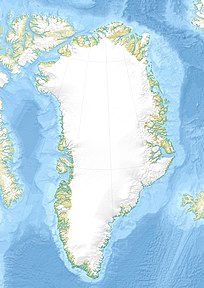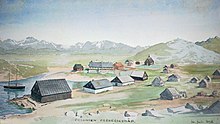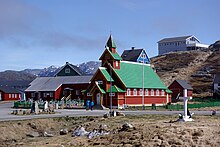Paamiut
| Paamiut (resident of the estuary) | ||
|---|---|---|
|
Frederikshåb (Frederik's Hope) Pâmiut |
||
| Paamiut (2011) | ||
| Commune | Kommuneqarfik Sermersooq | |
| District | Paamiut | |
| Geographical location | 61 ° 59 '44 " N , 49 ° 39' 49" W | |
|
|
||
| Residents | 1,308 (January 1, 2020) |
|
| founding | 1742 | |
| Time zone | UTC-3 | |
Paamiut [ ˈpaːmiut ] (according to the old spelling Pâmiut , Danish Frederikshåb ) is a Greenland city in the Paamiut district in the Sermersooq municipality .
location
Paamiut is at the tip of a peninsula in southwest Greenland. Off the coast of Paamiut is an archipelago with over a hundred islands. The Qinngunnguaq fjord arm , on which Paamiut lies, is a branch of the mouth of the Kuannersooq (Kvanefjord), one of the largest fjords in the area. The peninsula on which Paamiut lies is bounded in the north by Nerutusoq and cut by further fjords and bays, namely by the bay Tasiusannguaq and the fjords Kangerluarsuk and Nigerleq in the north and by the bay Taartoq and the fjords Eqaluit and Sammisoq in the south. The nearest inhabited places are Arsuk, 112 km south, and Qeqertarsuatsiaat, 132 km north . Paamiut has the largest stocks of fin whales , humpback whales and sea eagles in Greenland.
history
18th and 19th centuries

Jacob Severin founded Paamiut in 1742, where he named the place Frederikshåb in honor of King Frederick V of Denmark and Norway . The ship that brought the first colonists to Paamiut sank on the way back to Denmark. The second ship, which was supposed to bring building materials, also had to winter in Norway and only reached the colony with a delay. It was not until 1746 that the colony was sails according to plan. In 1747 the ship that was supposed to bring provisions and supplies had to turn back due to a storm. In 1748 Jacob Severin asked to give up the colony because of the high costs and risks, but this was not carried out. The first house measured almost 87 m² and had three rooms, which were inhabited by the merchant and his employees, the missionary and the sailors. There was also an 82 m² bacon house and a peat wall house. The first church was consecrated on August 30, 1772, but it was still under construction in 1774, so that it was dilapidated again in 1782. The house was occupied in 1828 by the merchant, the assistant and two craftsmen. At that time there was also the church, a brewery, a supply and material house, a bacon house and a distillery. The Greenlanders lived in seven Greenlandic houses.
In the 19th century, the colony lived mainly from hunting seals and whales. From 1900 the shark catch was of great importance, which brought the colony an economic boom.
20th century
From 1911 Paamiut was the main town of Frederikshaab, which still included the Kangilineq and Iluilaarsuk residential areas . It was part of the 6th District Council of South Greenland.
In 1918 there were seven Europeans and 201 Greenlanders living in Paamiut, who by the standards of a colony were extremely rarely of European descent. Among the Greenlandic population were 29 hunters, two fishermen, a blacksmith and ruler, two boatmen, three carpenters, three coopers, an engine mechanic, a cook, an apprentice and a midwife who ran the hospital. Then there was the Danish colonial administrator, who at that time was also training a Danish Udsteds administrator to work in one of the surrounding communities.
There was an apartment for the colonial administrator in 1918, which was also inhabited by the pastor or assistant after the pastor's apartment was destroyed in a fire in 1910. The apartment was a floor building with two apartments, seven rooms and attic chambers. The cooperage and carpentry workshop was a half-timbered building built in 1900. The shop dates from 1866 and, like the bakery and brewery from 1873, was a stone building. The food store from 1780 was the oldest building in the colony and a timber-framed timber-framed building. In addition, the trade still had a stone oil booth and a stone oil house from 1901 as well as a barrel house, a material and coal house, a boathouse, a forge, a stable and several provisions and powder houses. There was also a stone hospital from 1876, a peat wall house from 1902, which served as a guest apartment for the relatives of the patients, a church from 1908 and a school with two rooms. The Greenland population lived in 25 houses.
In the 20th century, shark fishing was replaced by cod fishing, which became so important that plans were made in the 1960s to develop Paamiut into the second largest city in Greenland, home to 10,000 people. In 1967 the fish factory was built, which at that time was one of the largest in the North Atlantic. However, from the 1980s onwards, fishery yields fell sharply and Paamiut fell into an economic crisis.
From 1950 to 2008 Paamiut was the capital of the Paamiut municipality , to which only Arsuk belonged at last . Paamiut has been part of the Kommuneqarfik Sermersooq since 2009 .
List of colonial employees until 1921
Colonial administrator
The following colonial administrators were responsible for the Frederikshaab colony until 1921.
- 1742–1743: Jacob van der Wida Geelmuyden
- 1743–1748: Lars Dalager
- 1748–1750: Jochum Grønbech (interim)
- 1750–1752: Lars Dalager
- 1752–1754: Carl Christopher Dalager
- 1754–1761: David Emanuel Christian Wulf
- 1761–1774: Peter Rasmus Petersen
- 1774-1779: Carl Bruun
- 1779–1786: Abraham Martinus Sandholt
- 1786–1790: Hans Henrik Raun
- 1790–1794: Johan Christian Mørch
- 1795-1801: Gert Falck
- 1801–1805: Nikolaj Daniel Muus
- 1805–1811: Ananias Christian Astrup
- 1811–1815: Jørgen Monrad
- 1815–1816: Jonas Jansen Berglund (interim)
- 1816–1822: Jørgen Monrad
- 1822: Andreas Christian Hviid (interim)
- 1822-1827: Rasmus Jensen
- 1827–1828: Jens Mathias Mathiesen
- 1828–1829: Johan Anton Lund
- 1829–1830: Jens Mathias Mathiesen
- 1830–1832: Johan Peder Engholm
- 1832–1833: Jens Mathias Mathiesen
- 1833–1834: Johan Peder Engholm
- 1834–1835: Jacob Andreas Augustinus Arøe
- 1835–1838: Jørgen Nielsen Møller
- 1838–1839: Jacob Andreas Augustinus Arøe
- 1839–1840: Henning Ager
- 1840–1845: Edvard Emil Meyer
- 1845–1846: Peter Hanning Motzfeldt (interim)
- 1846–1852: Edvard Emil Meyer
- 1852–1857: Lars Jensen
- 1857–1861: Bendix Andreas Heide Tvede
- 1861–1863: Halldór Ásgrímsson
- 1863–1864: Jonathan Mathiesen
- 1864–1865: Albert Emil Blichfeldt Høyer
- 1865–1869: Halldór Ásgrímsson
- 1869–1873: Carl Emil Olfert Lytzen
- 1873–1875: Jonathan Mathiesen
- 1875–1880: Lorentz Frederik Mathiesen
- 1880–1883: Henrik Martinus Rosenstand
- 1883–1887: Rasmus Müller
- 1887–1892: Peter Jürgen Petersen
- 1892: Valdemar Møller (interim)
- 1892–1895: Andreas Peter Rye Jørgensen
- 1895–1899: Oscar Peter Cornelius Kock
- 1899–1904: John Christian Gustav Baumann
- 1904–1905: Otto Rudolph Binzer
- 1905–1906: Konrad Olsen Bugge
- 1906–1910: Otto Rudolph Binzer
- 1910–1911: Oluf Nicolaj Willemann throne
- 1911–1912: Poul Hermann Ibsen
- 1912–1915: Carl Peter Lauritz Mathiesen
- 1915–1916: Poul Hermann Ibsen
- 1916–1917: Christian Simony (interim)
- from 1917: Poul Hermann Ibsen
Missionaries and pastors
The following missionaries and pastors worked in the colony until 1921. Several times the colony was subordinated to other parishes. From 1792 to 1794, 1796 to 1797, 1815 to 1820, 1825 to 1841, 1863 to 1864 and 1868 to 1869 the missionary of the Colony Godthaab was responsible, from 1820 to 1825, 1850 to 1851, 1879 to 1884 and 1887 to 1892 the missionary the colony Julianehaab . From 1795 to 1796, 1812 to 1815 and 1914 to 1915 there was no missionary or pastor in the Frederikshaab colony.
- 1742–1746: Arnoldus von Westen Sylow
- 1746–1754: Ambrosius Petersen book
- 1754–1759: Nicolai Nielsen Rasch
- 1759–1761: Jochum Grønbech (catechist)
- 1761–1768: Jørgen Meyer Myhlenphort
- 1768–1773: Otto Fabricius
- 1773-1775: Jørgen Meyer Myhlenphort
- 1775–1784: Christian Transe
- 1784–1792: William Alexander Meyer
- 1794–1795: Niels Giævertsen Titchen
- 1797–1806: Andreas Rosenvold
- 1806–1812: Johan Jessen
- 1841–1842: Johan Georg Rasmus Nielsen
- 1851–1855: Ludvig Andreas Mossin
- 1855–1863: Frederik Theodor Barfoed
- 1864–1868: Johannes Emil Wiberg
- 1869–1874: Lauritz Theodor Ostenfeldt
- 1874–1879: Peter Christian Jensen
- 1884–1887: Edvard Ægidius Lützen
- 1892-1897: Mads Rasmussen
- 1897–1904: Jens Christian Jensen Langer
- 1904–1914: Knud Otto Georg Wassmann
- from 1915: Karl Johan Pavia Chemnitz
economy
Despite the decline in cod in the 1980s, Paamiut is one of Greenland's largest fish factories, which today mainly processes shrimp and crabs . However, most of the population works in administration.
Infrastructure and supply
Paamiut has a shipping port operated by Royal Greenland and a smaller leisure port. Nowadays the sea is ice-free and navigable all year round. Paamiut Airport , which opened in 2007 and is located two kilometers north of the city, has air connections to Nuuk and Narsarsuaq airports . Paamiut has an extensive road network.
Nukissiorfiit guarantees the electricity, water and heating supply in Paamiut. Garbage is dumped in the garbage dump in the south of the city, while sewage is discharged into the sea. The residents of Paamiut are supplied with goods by a Brugseni and a Pilersuisoq branch.
Development
The school in Paamiut is Atuarfik Tuiisaq, which was built in 1926 and last expanded in 1969. Paamiut has also been the seat of the Greenland nautical school Imarsiornermik Ilinniarfik since 1996 . The city also has a day nursery, two kindergartens and an old people's home, as well as an assembly building, a village office, a police station, a hospital, a sports hall, the Paamiut Museum , a hotel and the church from 1909, which is reminiscent of the Norwegian architectural style Stave churches is ajar.
Sons and daughters
- Lorentz Frederik Mathiesen (1832–1920), Danish merchant and inspector of Greenland
- Signe Rink (1836–1909), Greenland-Danish writer and ethnographer
- Jakob Hegelund (1871–?), Provincial Councilor
- Pavia Petersen (1876–?), Provincial Councilor
- Jonathan Petersen (1881–1961), composer, songwriter, poet, writer, linguist, organist and university lecturer
- Anthon Petersen (1907–1984), fisherman and councilor
- Knud Hertling (1925-2010), Greenland-Danish politician (Siumut) and writer
- Enok Poulsen (* 1960), musician and painter
- Miki Jacobsen (* 1965), artist
- Kim Kielsen (* 1966), politician (Siumut) and Prime Minister
Population development
Paamiut's population has been falling steadily since the mid-1980s with the decline in cod stocks. In absolute numbers, no place in Greenland has since lost as many inhabitants as Paamiut: a total of over 1,000 people have left Paamiut since then, more than twice as many as the second most affected cities of Qasigiannguit , Narsaq and Maniitsoq .

Web links
Individual evidence
- ↑ Map with all official place names confirmed by Oqaasileriffik , provided by Asiaq
- ↑ a b Paamiut at groenlandkreuzfahrt.de
- ↑ Louis Bobe : Beskrivelse af Distrikterne i Sydgrønland: Frederikshaab district. History. Colonies . In: Georg Carl Amdrup , Louis Bobé , Adolf Severin Jensen , Hans Peder Steensby (eds.): Grønland i tohundredeaaret for Hans Egedes landing (= Meddelelser om Grønland . Volume 60-61 ). tape 2 . C. A. Reitzel Boghandel, Copenhagen 1921, p. 371 f . ( Digitized in the Internet Archive ).
- ↑ a b c d Paamiut in Den Store Danske
- ↑ Ole Bendixen : Beskrivelse af Distrikterne i Sydgrønland: Frederikshaab District. Bopladser i Frederikshaab district. Colonies of Frederikshaab . In: Georg Carl Amdrup , Louis Bobé , Adolf Severin Jensen , Hans Peder Steensby (eds.): Grønland i tohundredeaaret for Hans Egedes landing (= Meddelelser om Grønland . Volume 60-61 ). tape 2 . C. A. Reitzel Boghandel, Copenhagen 1921, p. 353 ff . ( Digitized in the Internet Archive ).
- ^ A b Hother Ostermann : Beskrivelse af Distrikterne i Sydgrønland: Frederikshaab district. History . In: Georg Carl Amdrup , Louis Bobé , Adolf Severin Jensen , Hans Peder Steensby (eds.): Grønland i tohundredeaaret for Hans Egedes landing (= Meddelelser om Grønland . Volume 60-61 ). tape 2 . C. A. Reitzel Boghandel, Copenhagen 1921, p. 372 f . ( Digitized in the Internet Archive ).
- ↑ a b c Paamiut at sermersooq2028.gl (.pdf)
- ↑ Number of inhabitants Paamiut 1977–2020 at bank.stat.gl





